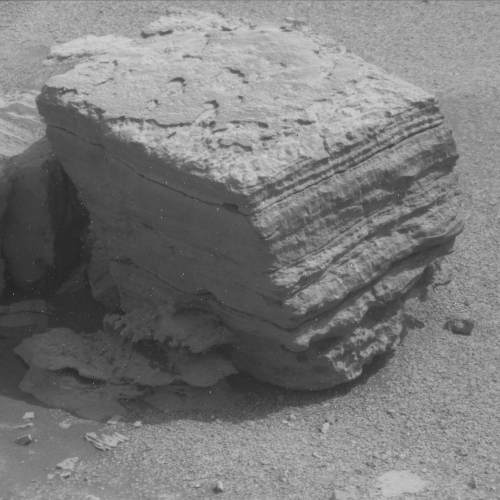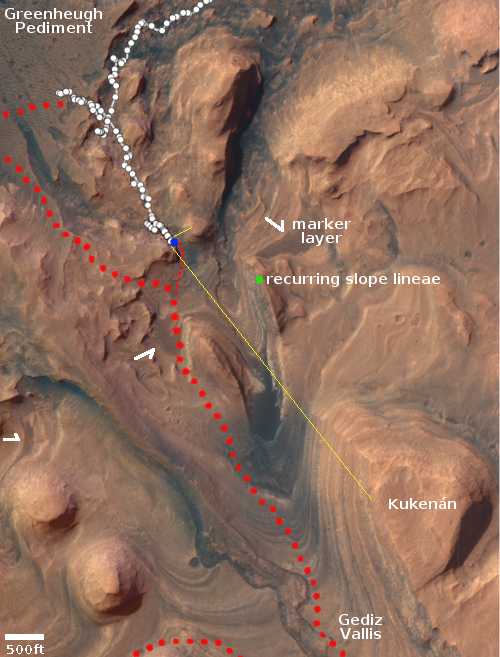A typical Martian rock on Mount Sharp

Click for full 360 degree panorama.
Cool image time! The photo to right, taken by the Mars rover Curiosity on August 9, 2022, provides a nice close-up of what might be a somewhat typical rock on the flanks of Mount Sharp in Gale Crater, many layered with some of those layers extending outward to the side for somewhat ridiculous distances as thin flakes.
The scientists call it a float rock, because they think it actually fell from the cliff dubbed Bolivar in the panorama above. Thus, it gives geologists data on the layers higher up that are not easily accessible from Curiosity’s present position.
The panorama is a mosaic created from images taken by the rover’s right navigation camera on August 8, 2022. The white arrow marks the rock. The green dot marks the approximate location on the cliff face of a previously observed recurring slope lineae, streaks that appear to come and go seasonally whose origin is still not understood.
The red dots mark my guess as to the route engineers will pick for Curiosity as it weaves its way around the other float rocks ahead.
The saddle directly ahead of the rover has been dubbed by the science team Paraitepuy Pass. As shown on the overview map to the right, Curiosity has been carefully picking its way around similar rocks as it attempts to work its way through the pass and down into Gediz Vallis. It is not quite there, but once it turns the corner it will finally get its first good look into this canyon, after ten years of travel to reach it.
The yellow lines mark the approximate area covered by the panorama. The marker layer is a specific geological layer that scientists have identified from orbital images in many locations at about the same elevation on the flanks of Mount Sharp. The large red dots indicate Curiosity’s original planned route, with the smaller red dots indicating its probable route to get back to that path.
The pace of travel in this rough terrain has been slow, because of rocks like the one above. It also appears that Curiosity’s pace from now on will always be as slow, because all of the terrain ahead appears as rough. The rover has left the soft gentle floor of Gale Crater. It is now climbing a mountain.
On Christmas Eve 1968 three Americans became the first humans to visit another world. What they did to celebrate was unexpected and profound, and will be remembered throughout all human history. Genesis: the Story of Apollo 8, Robert Zimmerman's classic history of humanity's first journey to another world, tells that story, and it is now available as both an ebook and an audiobook, both with a foreword by Valerie Anders and a new introduction by Robert Zimmerman.
The print edition can be purchased at Amazon or from any other book seller. If you want an autographed copy the price is $60 for the hardback and $45 for the paperback, plus $8 shipping for each. Go here for purchasing details. The ebook is available everywhere for $5.99 (before discount) at amazon, or direct from my ebook publisher, ebookit. If you buy it from ebookit you don't support the big tech companies and the author gets a bigger cut much sooner.
The audiobook is also available at all these vendors, and is also free with a 30-day trial membership to Audible.
"Not simply about one mission, [Genesis] is also the history of America's quest for the moon... Zimmerman has done a masterful job of tying disparate events together into a solid account of one of America's greatest human triumphs."--San Antonio Express-News

Click for full 360 degree panorama.
Cool image time! The photo to right, taken by the Mars rover Curiosity on August 9, 2022, provides a nice close-up of what might be a somewhat typical rock on the flanks of Mount Sharp in Gale Crater, many layered with some of those layers extending outward to the side for somewhat ridiculous distances as thin flakes.
The scientists call it a float rock, because they think it actually fell from the cliff dubbed Bolivar in the panorama above. Thus, it gives geologists data on the layers higher up that are not easily accessible from Curiosity’s present position.
The panorama is a mosaic created from images taken by the rover’s right navigation camera on August 8, 2022. The white arrow marks the rock. The green dot marks the approximate location on the cliff face of a previously observed recurring slope lineae, streaks that appear to come and go seasonally whose origin is still not understood.
The red dots mark my guess as to the route engineers will pick for Curiosity as it weaves its way around the other float rocks ahead.
The saddle directly ahead of the rover has been dubbed by the science team Paraitepuy Pass. As shown on the overview map to the right, Curiosity has been carefully picking its way around similar rocks as it attempts to work its way through the pass and down into Gediz Vallis. It is not quite there, but once it turns the corner it will finally get its first good look into this canyon, after ten years of travel to reach it.
The yellow lines mark the approximate area covered by the panorama. The marker layer is a specific geological layer that scientists have identified from orbital images in many locations at about the same elevation on the flanks of Mount Sharp. The large red dots indicate Curiosity’s original planned route, with the smaller red dots indicating its probable route to get back to that path.
The pace of travel in this rough terrain has been slow, because of rocks like the one above. It also appears that Curiosity’s pace from now on will always be as slow, because all of the terrain ahead appears as rough. The rover has left the soft gentle floor of Gale Crater. It is now climbing a mountain.
On Christmas Eve 1968 three Americans became the first humans to visit another world. What they did to celebrate was unexpected and profound, and will be remembered throughout all human history. Genesis: the Story of Apollo 8, Robert Zimmerman's classic history of humanity's first journey to another world, tells that story, and it is now available as both an ebook and an audiobook, both with a foreword by Valerie Anders and a new introduction by Robert Zimmerman.
The print edition can be purchased at Amazon or from any other book seller. If you want an autographed copy the price is $60 for the hardback and $45 for the paperback, plus $8 shipping for each. Go here for purchasing details. The ebook is available everywhere for $5.99 (before discount) at amazon, or direct from my ebook publisher, ebookit. If you buy it from ebookit you don't support the big tech companies and the author gets a bigger cut much sooner.
The audiobook is also available at all these vendors, and is also free with a 30-day trial membership to Audible.
"Not simply about one mission, [Genesis] is also the history of America's quest for the moon... Zimmerman has done a masterful job of tying disparate events together into a solid account of one of America's greatest human triumphs."--San Antonio Express-News




It’s interesting how rectangular that rock is!
Minor edit in penultimate paragraph: “with the smaller red dots indicating its probable route to get back to that path.”
Andi. Fixed. Thank you!
I look at that rock and I think sedimentary. When I think sedimentary I think water.
Turn it on its side, split it and look for fossils.
“Deepdale”….”Boliver”….Invading colonial’s names – WE MUST CALL THEM BY THE NAMES THE MARTIANS HAVE GIVEN THEM !!!
Ok, it’s Bolivar, not Boliver
‘I love to go a-wandering
Along a Martian hill
And as I go, the rocks I see
Give scientist a thrill’
First peek over the saddle.
http://www.unmannedspaceflight.com/index.php?act=attach&type=post&id=51600
The latest view (sol 3560) from Jan van Driel
Is looking at rocks on Mars still “geology” or have we decided there will be a different name for “looking at rocks” on each planet? Xenogeology makes some sense, right now, but as the list of planets grows, that will become an odd distinction. (Is it xenogeology if it’s a Martian resident looking at Martian rocks?)
markedup2,
How about areionology? The apoapsis (apogee)and periapsis (perigee) for Mars are called apareion and periareion, with areion being the suffix, based upon the Greek god Ares. Areion may be a suitable prefix.